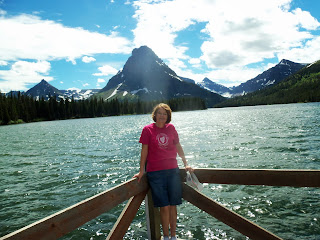The centerpiece park for this
trip is Glacier National Park. We have never
been here before and wanted to see it before the glaciers are all gone. Our four days here have been wonderful. We started in the southeast corner in a
hidden gem that many Glacier visitors miss—Two Medicine valley. Lush forests and flowers fill the landscape.
Running Eagle Falls is named
in honor of a famous medicine woman warrior of the local Pikuni or Blackfeet people.
Two Medicine Lake in the southeast corner of Glacier

Bear Grass is one of the more
unusual of the many wildflowers in full bloom right now.
You can’t beat the atmosphere
at dinner when you park your own condo-on-wheels in scenic parks.
Going to the Sun Road through
Glacier NP lived up to its reputation as one of the most spectacular roads in
the world. Our big truck took the
mountains as though it was flat, but not so my quivering insides as I clung to
the road with only a low rock border between me and the valley 1000 feet
below. Going up was just as bad, trying
to stay in my lane without scraping the rock walls that the road had been
carved from. These small falls of the weeping wall ran right onto the road.
Enormous glaciers once
covered most of the area and gouged out U shaped valleys, narrow ridges, and
high angular peaks. Today’s glaciers
move slowly down the mountainsides and feed rushing icy streams and high waterfalls
everywhere.
Jackson and Blackfoot Glaciers used to be much bigger and piled together. Scientists are predicting that the remaining 34 glaciers in this park will be gone by 2030.
This is a more typical view.
We were surprised to learn
that the continental divide which reaches through the park is actually a
three-way divide. One triangular
mountain splits watersheds going to the Columbia River and the Pacific in the west; the Missouri, Mississippi, Gulf
and Atlantic in the east and Hudson Bay and the Arctic Ocean in the north.
Don is doing so well with the hiking, as long as we are on trails that
are not too rough with rocks and roots.
I try to steer him around on trails to the smoothest paths. I do well—98% of the time. That 2% that I miss because I am looking at
flowers or waterfalls causes some stress.
But he is a trooper.
Logan Pass at 6646 feet let us enjoy the warm temps in the eighties
while trudging through snow.
Birdwoman Falls
Glacial ice does not float in fresh water because it has so much silt in it. This glacial “flour” flows down in the glacial melt water and remains suspended in the rivers and lakes, giving the waters the lovely azure color. Simple snow melt does not look the same.
Lake McDonald is the large lake at the west side of Glacier. We had a lovely steak lunch at McDonald Lodge before returning
over the Going to the Sun Road to our campground in St. Mary on the east. When the park was first promoted by the Great Northern Railway, several rustic lodges, luxurious for the time, were built. They are still beautiful places to visit.



Don holds a root beer bottle featuring the restored 1930's Red Jammer busses still used for tours throughout the park.
As with most mountainous places in the west, the eastern side of the
range is drier because the humid Pacific air hits the mountains and rains on
the west side. Glacier is no exception. This park has a variety of ecosystems. As people who know me can attest, I love,
love, love trees.
The Trail of the
Cedars on the west side with its enormous red cedars and other trees was a solemn, almost
cathedral-like place in which to praise God for His creation.
We spent most of our last day at the Many Glacier area with breakfast at the lodge there and a two part boat journey with a quarter mile walk over the hill between the two lakes and two boats.
Then we hiked out to Grinnell Lake. This is the swaying-est hanging bridge I have ever been on.
Grinnell Lake is so lovely with the waterfalls coming down from Grinnell Glacier in braided ribbons of white. Look at that water color.
Don soaked his feet in the icy waters of Grinnell Lake after our hike.
Glacier NP is at the meeting of mountains and plains. Sunset from our campsite.
“Few places in the world are more dangerous than home. Fear not, therefore, to try the mountain passes. They kill care, save you from deadly apathy, and call forth every faculty into vigorous, enthusiastic action.” John Muir on visiting Glacier.











































































